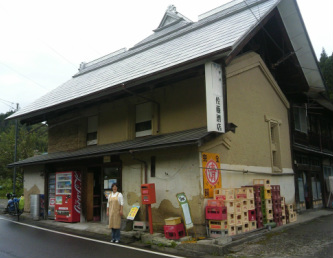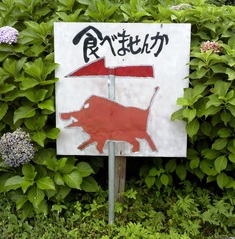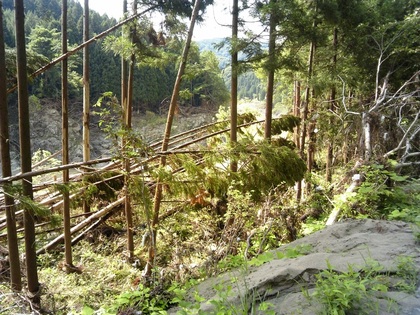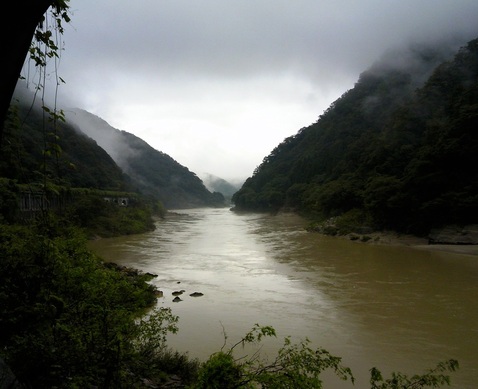There were two possible routes west from Aizu-wakamatsu towards Niigata, and the decision as to which one to take was based on my Touring Mapple. Mapple is a map company whose logo is an apple (map + apple = Mapple. Geddit?), and while their ‘touring’ series is aimed primarily at motorcyclists, it’s just as handy for those of us using pedal power, because even if you can’t read Japanese, most of the roads have numbers, and there are easy-to-understand symbols for campsites, convenience stores, onsen and restaurants – in other words, everywhere you’re going to go to on the way to wherever it is you’re going to go to. Another feature of the Touring Mapple is that particularly scenic or fun-to-ride routes are highlighted in purple, and while Route 49 was a run-of-the-mill red A-road, Route 459 was purple almost all the way to Niigata, so I spent the morning admiring some rather lovely mountain scenery.
This shop was in one of the few villages I passed through along the way, and I asked the nice lady who worked there about the history of the building, whose interior resembled something distinctly olde worlde, its great wooden beams turned smooth and a rich dark brown with age.

‘I didn’t move here until I got married,’ she said, ‘so I can’t tell you much, but they call this stuff kura.’ Kura (蔵) means ‘warehouse’, and is shorthand for any building that uses wattle and daub – ie. wooden latticework covered in dried mud or clay. ‘If you go outside you can see where it cracked in the earthquake, but we can repair that, and it’s warm in winter.’
The closer to the Japan Sea coast you get, the more extreme the winter weather becomes, and as well as kura, since Lake Inawashiro I had seen more and more totan-yané (トタン屋根 / tin roofs), which are lighter than the tiled variety, and less likely to collapse under the weight of large amounts of snow. This one was even fitted with heating elements, presumably to melt the snow before it has a chance to build up.


Ignoring the above sign (‘How about eating some wild boar meat?’), I stopped for lunch in the village of Miyako, which declared itself as soba-no-sato (そばの里 / the hometown of soba noodles), and where thirteen of the thirty households are in business as soba restaurants. As the first customer of the day at Kawamaé, I naturally ordered the cheapest thing on the menu, although when my set meal arrived, there was enough of it to feed a whole family, including a limitless supply of noodles, mushrooms with grated daikon (大根 / daikon is a big, white radish that English-speaking vegetable lovers will know as mouli), tsukemono (漬け物 / pickled vegetables), konnyaku (こんにゃく / devil’s tongue – a weird kind of calorie-free vegetable jelly), nimono (煮 物 / boiled vegetables and fishcakes), soba-flavoured green tea, and a cup of what is essentially diluted soy sauce, into which you dip your noodles before eating them. There was also grated wasabi and diced spring onions to be mixed into the sauce, and a separate pot of soba-yu, the still-warm and starch-y water in which the soba has been cooked, which the waitress told me to add to the sauce and drink at the end of the meal.
By mid-afternoon I had reached the Agano River, whose water was light brown and completely opaque: the same colour as a proper cup of tea, now I come to think of it. On first sight it looked as if there was a drought, as the river was lined on both sides with a wide band of bare earth, but as I cycled along, it became clear that rather than subsiding from its normal level over the course of several months, the river had risen suddenly, washing away almost everything in its path.

Just over three weeks before, parts of Niigata and Fukushima had suffered their heaviest rainfall in thirty years: in Aga Town just downstream, 50mm fell in the space of just ten minutes, which is a national record, and elsewhere there was anything up to 700mm over the course of three days. In the resulting floods, four people lost their lives, seven were seriously injured, and 173 people had to be airlifted to safety after they were stranded at a local school. In places the water level rose by an incredible 24 metres, and both of the dams along the Agano overflowed – this one was thankfully back to normal, although you can still see some of the mud that was left behind.

The aftermath of the flood looked eerily similar to images of the 11th March tsunami: countless trees had been felled or washed away, dunes of sandy mud – now hardened and cracked – had been deposited on the forest floor, clumps of foliage and rubbish were lodged in the roadside crash barriers, and bulldozers were at work clearing away the wreckage.
‘You’ll be lucky to find a campsite,’ said a shopkeeper in the town of Tsugawa, who had stopped me to ask where I was going. ‘Most of them have been washed away.’
He was wiry and tanned with grey stubble on his chin, and wore a baggy white vest with a pen clipped inside the collar, and we were joined by one of his customers, who had an almost full set of silver caps on his teeth, and eyebrows so black and bushy they looked two Groucho Marx moustaches.
‘There’s a campsite in Kanosé which is quite high up,’ said the shopkeeper.
‘Actually I’ve just come from there. I was thinking of carrying on to Mikawa instead.’
‘That’s next to the river, isn’t it?’
‘You could be right,’ said the customer.
‘Plus it’ll be getting dark soon, and if it’s going to rain’ – a few spots had begun to fall as we were chatting – ‘you’d be better off finding somewhere near here.’
‘I can’t really see anywhere on the map.’
‘How about near the station? There’s an onsen behind it that only costs 300 yen, and you could stay in a bus shelter. They’re not very big but at least you’d be dry, and the buses finish early so no one will bother you. Better than getting stranded halfway between here and Mikawa.’
The shopkeeper gave me a bag of chocolates to send me on my way, and as the heavens opened an hour later, I realised that I should have heeded his advice. Conditions like this called for four walls and a roof, although perhaps not the four walls and a roof of a bus shelter, so I ducked into the nearest shop and asked the couple who worked there if they knew of a cheap place to stay.
‘They’ve got vacancies tonight,’ said the husband, after calling a hotel called Yuu-ando-yu (You&湯, which is a rather corny pun on the English ‘you’ and the Japanese yu, meaning ‘hot water’), ‘and it’ll be cheaper than the other places around there. Shin-mikawa is an onsen resort, you see, but Yuu-no-yu is run by the local council.’
‘How much is it, though?’ I asked.
Evading my question, he proceeded to give me directions to Yuu-ando-yu, and on the way I spotted what appeared to be the campsite I was originally aiming for. The sign at the entrance was hard to decipher, and as I was reading my way through the list of facilities – which included a ski slope, among other things – a car pulled over next to me and the driver wound down her window.
‘Are you on your way to Yuu-ando-yu?’ she said.
‘Er, yes. How did you know?’
‘I work there. I was just going home and I heard there was someone on a bicycle coming to stay. Do you want me to guide you in?’
A few minutes later I was standing at the Yuu-ando-yu reception desk, filling out my details on a check-in form. When I’d finished, the receptionist handed me a key and said, ‘I’ll show you to your room now.’
‘Er, just one more thing,’ I said. ‘Um, would you mind telling me, er, how much it’s going to cost. For one night, that is. I’m on a bit of tight budget, you see.’
‘5000 yen,’ he said.
‘5000 yen?’
‘Oh,’ I said, looking out of the lobby doors at the still pouring rain. ‘I see.’
‘If you’ll just follow me.’
Setsu-den (節電 / saving electricity) has been the watchword in Japan over the past six months, although the management at Yuu-ando-yu didn’t appear to be too fussed about such trifling matters as a national power shortage. The tea urn in my room was bubbling away at 95°c, the cooler was pumping out air at 23°c (bizarrely, it was several degrees cooler outside), a fridge full of beer and soft drinks was set to the highest notch on the dial, the heated toilet seat was on full, and all four bulbs in both ceiling lights were lit up. Half-board at Yuu-no-yu would have set me back another 3000 yen, so once I had turned everything off or down and collected what I needed from the bicycle, I took the receptionist up on his offer of a lift to the nearest convenience store to buy some dinner.
‘Was the hotel flooded?’ I asked as we headed back towards Mikawa.
‘The water came all the way up the valley and stopped at the car park. Some people weren’t so lucky, though. You see these houses on the left? The first floors were completely underwater – some of them will have to be knocked down and rebuilt.’
In the onsen a little later I got talking to Kanezuka-san, who made his living as a piano tuner.
‘My wife teaches the taishoh-goto in the building next door,’ he said, ‘and if the weather’s bad I give her a lift from Niigata City.’
‘What’s a taishoh-goto?’
‘You’re not busy, are you?’
‘Not at all. I was going to go back to my room and eat a Cup Noodle in front of the TV.’
‘Well, I’ll take you along and you can have a listen.’
As soon as we got to the classroom I was sat down in front of a taishoh-goto (大正琴), which is a modern version of the koto, a stringed instrument played horizontally like a lap steel (as opposed the shamisen / 三味線, which looks and plays more like a banjo). Mrs Kanezuka unearthed an English language song – The Sound Of Silence – and I was relieved to discover that I didn’t have to be able read music to join in. Rather than frets, the taishoh-goto has numbered keys, so all you have to do is strum its closely bunched strings with a plectrum, and press 2 2 3 3 5 5 4 / 1 1 1 2 2 4 4 3 (or numbers to that effect) for ‘Hello darkness my old friend / I’ve come to talk with you again’.
After performing a couple of songs they had been working on, the students plied me with snacks and drinks, and by about 8 o’clock, Kanazuka-san noticed that I was looking sleepy, and wished me luck before I made my excuses and went upstairs for that Cup Noodle.
Read this one out of order! It’s the detail I love. It’s a great travelogue, although sometimes I’m mystified about your decisions. For example, the passing up Wild Boar Meat for noodles. How could you do that? Oh hang on. Forgot. You’re a veggie. Still, I think you could have taken one for your audience there.
As it happens I had some wild boar over the Christmas holidays last year, although to be honest it wasn’t up to much – a bit rich and a bit fatty. Weirdly, the things I miss most as a semi-veggie are liver and kidneys…